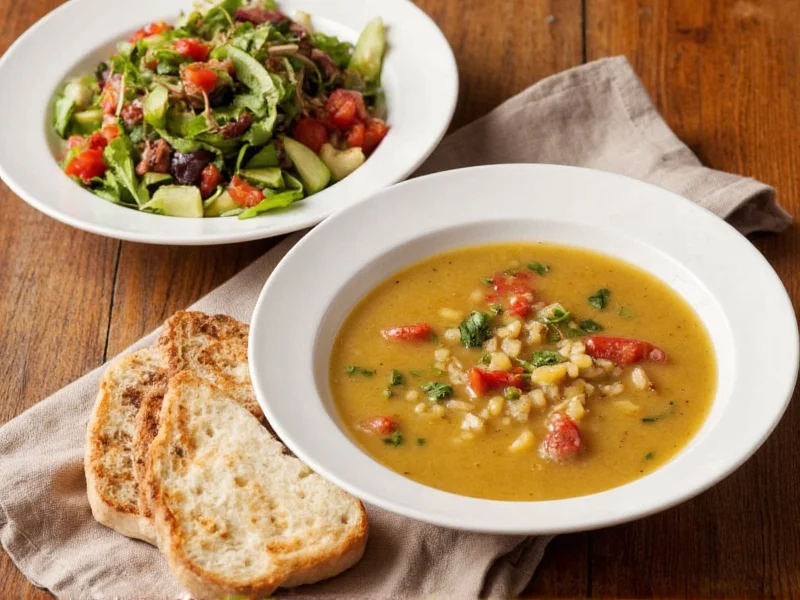For centuries, soup and salad have been served together as a complete meal that balances nutrition with culinary delight. This pairing isn't just a restaurant staple—it's a smart eating strategy that delivers maximum nutritional benefits while satisfying diverse taste preferences. Understanding how to properly combine these elements transforms a simple meal into a nutritionally balanced experience.
The Perfect Pairing: Why Soup and Salad Complement Each Other
The marriage of soup and salad works because of their complementary characteristics. Soup provides warmth, depth of flavor, and often protein or complex carbohydrates, while salad contributes freshness, crunch, and additional vitamins. This combination creates what food scientists call "sensory-specific satiety"—where the variety of textures and temperatures keeps your palate engaged longer, helping you feel satisfied with appropriate portions.
Historically, this pairing emerged from practical meal planning. In many European culinary traditions, soup served as the substantial first course, followed by a lighter salad to cleanse the palate. Over time, these elements merged into the single-meal concept we recognize today, particularly in American dining culture where lunch portions are typically smaller than dinner.
Classic Soup and Salad Combinations That Never Fail
Certain pairings have stood the test of time because they balance flavors and textures perfectly. Consider these time-tested combinations that work for various dietary needs and occasions:
| Soup Type | Recommended Salad Pairing | Why It Works |
|---|---|---|
| Cream of Tomato | Classic Caesar Salad | The acidity of tomato cuts through the richness of the cream, while the romaine provides necessary crunch |
| Chicken Noodle | Simple Green Salad with Lemon Vinaigrette | Light dressing complements without overwhelming the delicate soup flavors |
| Minestrone | Arugula Salad with Shaved Parmesan | Peppery arugula balances the hearty vegetable soup |
| Butternut Squash | Spinach Salad with Walnuts and Apple Slices | Sweetness complements, nuts add texture contrast |
| French Onion | Simple Arugula Salad | Peppery greens cut through the rich, sweet onions |
Nutritional Benefits of Soup and Salad Meals
When properly composed, soup and salad meals deliver impressive nutritional advantages. A well-constructed combination typically provides:
- Fiber diversity—from both cooked and raw vegetables
- Balanced macronutrients—carbohydrates from soup bases, protein from added ingredients, and healthy fats from salad dressings
- Hydration—soups contribute significantly to daily fluid intake
- Vitamin variety—raw vegetables in salads preserve heat-sensitive vitamins that might be reduced in cooked soup ingredients
Research shows that starting a meal with soup can reduce overall calorie consumption by 20% while increasing vegetable intake. Adding a side salad further enhances this effect, making soup and salad an excellent choice for weight management without sacrificing satisfaction.
Creating Your Own Pairings: A Practical Guide
Understanding the principles behind successful soup and salad combinations allows you to create your own pairings based on seasonal ingredients and dietary preferences. Follow these guidelines for perfect pairings every time:
Match Intensity Levels
Pair mild soups with boldly dressed salads, and robust soups with simply dressed greens. A delicate consommé would be overwhelmed by a heavily dressed Cobb salad, while a hearty chili needs the refreshing contrast of a light vinaigrette on mixed greens.
Consider Temperature Contrast
Hot soup with cold salad creates an appealing sensory experience. Avoid serving warm salads with hot soups unless specifically intended (like a warm beet salad with borscht). The temperature contrast enhances the dining experience and helps regulate eating pace.
Balance Textures Thoughtfully
Creamy soups benefit from crisp, crunchy salads, while chunky vegetable soups pair well with tender leafy greens. This textural interplay keeps each bite interesting and satisfying.
Serving Suggestions for Maximum Enjoyment
How you serve your soup and salad matters as much as the pairing itself. Professional chefs recommend:
- Portion proportions—soup should be 8-10 ounces, salad 2-3 cups for a balanced meal
- Serving sequence—present both simultaneously for casual meals, or salad first for more formal settings
- Utensil selection—provide both soup spoon and salad fork for comfortable eating
- Garnish coordination—use complementary garnishes (like chives on both elements) to visually unify the meal
Common Pairing Mistakes to Avoid
Even experienced cooks sometimes make these soup and salad pairing errors:
- Overpowering dressings—a heavily garlicked dressing can dominate delicate soups
- Temperature mismatches—serving cold soup with cold salad creates a monotonous experience
- Flavor repetition—combining tomato soup with a tomato-heavy salad lacks variety
- Portion imbalance—an oversized salad can make the soup feel like an afterthought
Remember that dietary restrictions don't have to limit your pairing options. For gluten-free needs, focus on broth-based soups with robust salads. Vegan pairings work beautifully with miso soup and seaweed salad, or black bean soup with avocado salad. The key is maintaining that essential balance between the elements.











 浙公网安备
33010002000092号
浙公网安备
33010002000092号 浙B2-20120091-4
浙B2-20120091-4